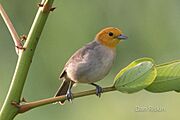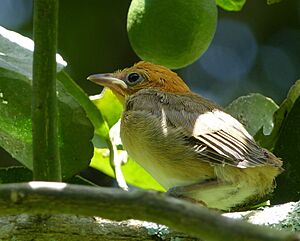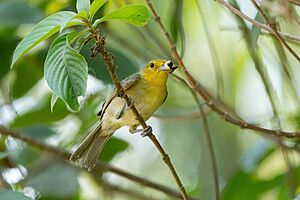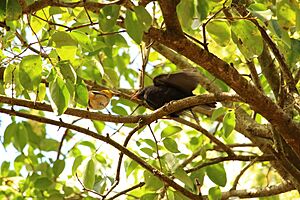Orange-headed tanager facts for kids
Quick facts for kids Orange-headed tanager |
|
|---|---|
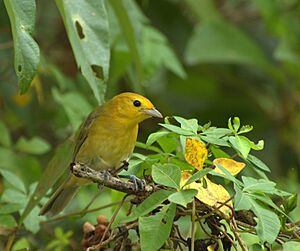 |
|
| Female of nominate subspecies | |
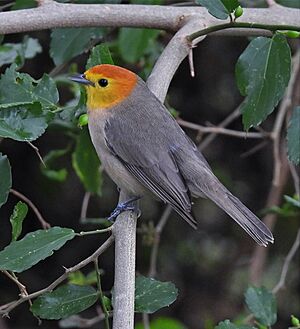 |
|
| Male of nominate subspecies | |
| Conservation status | |
| Scientific classification | |
| Genus: |
Thlypopsis
|
| Species: |
sordida
|
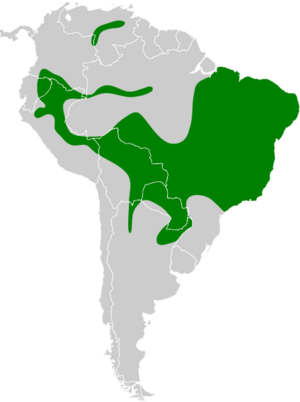 |
|
| Synonyms | |
The orange-headed tanager (Thlypopsis sordida) is a colorful bird found in South America. It lives in countries like Argentina, Bolivia, Brazil, Colombia, Ecuador, Paraguay, Peru, and Venezuela. These birds like to live in places with lots of plants, like forests near rivers, bushy areas, and open woodlands.
Male orange-headed tanagers have sandy-gray backs, cinnamon-colored undersides, and white on their lower chest and belly. Their heads are a mix of rufous-orange and yellow. Females look similar but have duller colors.
This bird is an omnivore, meaning it eats both plants and animals. Its diet includes insects, spiders, fruit, and seeds. It actively searches for food, often hopping around to pick up prey or sometimes catching it while flying. Orange-headed tanagers usually lay two bluish-white eggs with brown spots. The International Union for Conservation of Nature (IUCN) lists this bird as a species of least concern. This means its population is stable and its range is large.
Contents
About the Orange-headed Tanager
The orange-headed tanager was first described in 1837 by French scientists Frédéric de Lafresnaye and Alcide d'Orbigny. They first called it Nemosia sordida. Later, in 1851, a German scientist named Jean Cabanis moved it to the genus Thlypopsis.
The genus name, Thlypopsis, comes from ancient Greek words. These words mean "small bird" and "appearance." The specific name sordida comes from a Latin word meaning "dirty" or "shabby." The International Ornithologists' Union officially calls this bird the orange-headed tanager.
Different Kinds of Orange-headed Tanagers
There are three main types, or subspecies, of the orange-headed tanager:
- T. s. sordida (Lafresnaye and d'Orbigny, 1837): This is the main type. It lives from eastern Bolivia to Brazil, and south to Paraguay and northern Argentina.
- T. s. chrysopis (Sclater and Salvin, 1880): This type is found in southern Colombia, eastern Ecuador and Peru, and western Brazil. It has pure gray undersides and light grayish-brown sides and chests, which makes it different from the main type.
- T. s. orinocensis Friedmann, 1942: This type lives in central Venezuela. It has pale gray upperparts with a hint of grayish-cinnamon.
What the Orange-headed Tanager Looks Like
The orange-headed tanager is a small bird with a thin beak. It is about 13 cm (5.1 in) long and weighs about 14–19 g (0.49–0.67 oz). It looks similar to a New World warbler.
Male birds of the main type have rufous-orange crowns (tops of their heads) and sides of their heads. This color turns bright yellow around their eyes and on their throats. Their backs are sandy-gray. Their flight feathers are dark, with gray edges. Their undersides are buff to cinnamon, becoming whitish on the lower chest, belly, and under the tail. They have dark beaks, dark brown eyes, and gray legs.
Female orange-headed tanagers have duller colors than males. Their heads have less yellow, and the yellow on their face and throat is not as bright. Young birds look like females but are even duller. They have grayish-olive backs and paler undersides.
Bird Calls and Songs
The orange-headed tanager makes several different sounds. Its calls include a high-pitched tseet, seet, or sit, which it often repeats quickly. It also makes a fast, high-pitched chittering sound like sit-it-t-t-t-t-t-t, and a slower seet-a.
The bird's song changes depending on where it lives. In northern Peru and Ecuador, its song is high-pitched, rising and falling, and sounds like pits’a, see-a, pits’a, see-ee. In northwestern Argentina, it sings seet, sit, a see-fits-za. In eastern Brazil, the most common song is a thin, high-pitched tsap-tsip, tsip, tsip-tsop-tswit. They also make a high-pitched, trilled tsi . . . . tsrrrri sound in Brazil.
Where They Live and Their Home
The orange-headed tanager lives in South America. You can find it in Argentina, Bolivia, Brazil, Colombia, Ecuador, Paraguay, Peru, and Venezuela. It is the only bird in its group that lives in the lowlands of the Amazon rainforest.
In Venezuela and the western Amazon, it lives in new plant growth. This includes tall grasses, willows, and young forests near rivers and on river islands. In the southern Amazon, it lives in dry or semi-humid areas called cerrado, open woodlands, and forests next to water. In northwestern Argentina, it prefers scrub, brush, and the edges of dry open woodlands. It rarely goes into thick forests.
Orange-headed tanagers usually live at elevations up to 800 m (2,600 ft). However, in Venezuela, they are only found up to 100 m (330 ft), and in Colombia, up to 400 m (1,300 ft). Some groups in Bolivia can live as high as 1,500 m (4,900 ft). In Brazil and Argentina, these birds sometimes move from the Andes mountains to lower areas during the southern winter.
Behavior and Life
Orange-headed tanagers are usually seen in pairs or small groups of 3–4 birds. Sometimes, they join other bird species to find food together.
What They Eat
The orange-headed tanager is an omnivore. It eats many different things, including grasshoppers, crickets, beetles, flies, spiders, fruit, and seeds. It looks for food very actively, similar to a New World warbler. It picks insects off leaves while hopping around. Less often, it might hover or fly out to catch prey in the air.
Reproduction and Life Cycle
Orange-headed tanagers have been seen nesting in December. They build a cup-shaped nest about 2 m (6.6 ft) above the ground. They lay two bluish-white eggs with brown markings. Sometimes, another bird called the shiny cowbird lays its eggs in the tanager's nest. This means the tanager ends up raising the cowbird chicks.
Conservation Status
The orange-headed tanager is listed as a species of least concern by the International Union for Conservation for Nature (IUCN) on the IUCN Red List. This is because it has a very large range and its population is stable. In some areas, its habitat is being changed by humans, but it lives in many protected areas. It is also quite common on river islands and in river floodplains.



